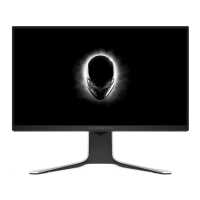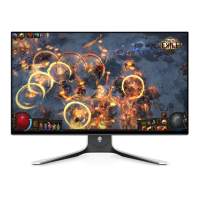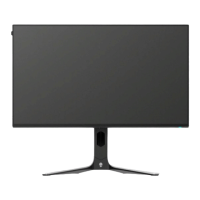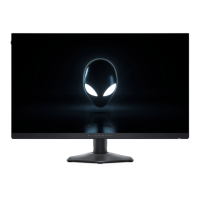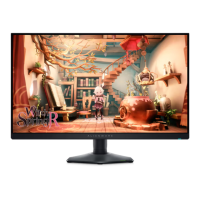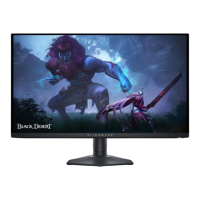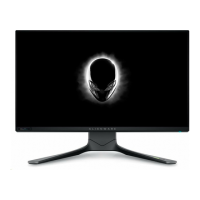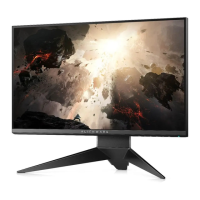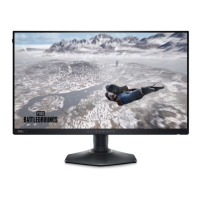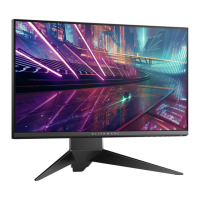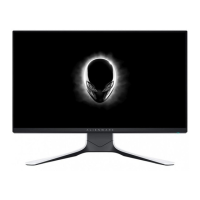Do you have a question about the Alienware AW2720HF and is the answer not in the manual?
Lists all components included in the monitor package.
Details the technical specifications and capabilities of the monitor.
Identifies and describes components visible on the front of the monitor.
Details components and connectors located on the back of the monitor.
Describes ports and connectors on the rear and bottom of the monitor.
Details supported display resolutions and refresh rates.
Lists the video display capabilities of the monitor across different modes.
Details various display modes and their technical parameters like frequency and polarity.
Outlines the electrical requirements, input signals, and power consumption.
Specifies dimensions, weight, and signal cable types for the monitor.
Details operating and non-operating conditions for temperature, humidity, and altitude.
Explains how the monitor manages power consumption, including standby and sleep modes.
Lists pin configurations for the DisplayPort connector.
Lists pin configurations for the HDMI connector.
Details the pin configuration for the USB upstream connector.
Details the pin configuration for the USB downstream connector.
Provides instructions and precautions for safely cleaning the monitor screen.
Step-by-step guide for assembling and attaching the monitor stand.
Instructions for connecting the monitor to a computer using various cables.
Step-by-step guide to safely detach the monitor stand from the display.
Instructions and guidelines for mounting the monitor using a VESA-compatible bracket.
Basic steps to turn the monitor on and off.
Explains how to use the joystick for OSD menu navigation and adjustments.
Describes the function of each button on the monitor's rear control panel.
Guides users on navigating OSD settings like Game, Display, Audio, and Menu.
Instructions on how to set the monitor to its maximum resolution in Windows.
Explains how to adjust the monitor's physical positioning for comfort.
Instructions for physically rotating the monitor display between landscape and portrait orientations.
Guides on configuring system display rotation settings after physically rotating the monitor.
Lists the requirements for installing the AWCC software on a non-Alienware system.
Steps to install Alienware Command Center via Windows Update.
Steps to download and install AWCC from Dell's official support website.
Explains how to use the AlienFX interface within AWCC to control LED lighting.
Step-by-step guide to create custom lighting themes for the monitor.
Details how to apply various lighting effects like Morph, Pulse, and Color.
Procedure to run a self-test to diagnose monitor functionality issues.
How to use the monitor's built-in diagnostic tool to identify screen abnormalities.
Lists common monitor issues, USB problems, and their potential solutions.
Addresses specific issues related to screen image size and OSD control panel.
Troubleshooting guide for USB interface and connectivity issues.
Important safety warnings and precautions for using the monitor.
Provides FCC notices, regulatory compliance, and Dell contact details.
Information on how to contact Dell support for assistance.
Lists all components included in the monitor package.
Details the technical specifications and capabilities of the monitor.
Identifies and describes components visible on the front of the monitor.
Details components and connectors located on the back of the monitor.
Describes ports and connectors on the rear and bottom of the monitor.
Details supported display resolutions and refresh rates.
Lists the video display capabilities of the monitor across different modes.
Details various display modes and their technical parameters like frequency and polarity.
Outlines the electrical requirements, input signals, and power consumption.
Specifies dimensions, weight, and signal cable types for the monitor.
Details operating and non-operating conditions for temperature, humidity, and altitude.
Explains how the monitor manages power consumption, including standby and sleep modes.
Lists pin configurations for the DisplayPort connector.
Lists pin configurations for the HDMI connector.
Details the pin configuration for the USB upstream connector.
Details the pin configuration for the USB downstream connector.
Provides instructions and precautions for safely cleaning the monitor screen.
Step-by-step guide for assembling and attaching the monitor stand.
Instructions for connecting the monitor to a computer using various cables.
Step-by-step guide to safely detach the monitor stand from the display.
Instructions and guidelines for mounting the monitor using a VESA-compatible bracket.
Basic steps to turn the monitor on and off.
Explains how to use the joystick for OSD menu navigation and adjustments.
Describes the function of each button on the monitor's rear control panel.
Guides users on navigating OSD settings like Game, Display, Audio, and Menu.
Instructions on how to set the monitor to its maximum resolution in Windows.
Explains how to adjust the monitor's physical positioning for comfort.
Instructions for physically rotating the monitor display between landscape and portrait orientations.
Guides on configuring system display rotation settings after physically rotating the monitor.
Lists the requirements for installing the AWCC software on a non-Alienware system.
Steps to install Alienware Command Center via Windows Update.
Steps to download and install AWCC from Dell's official support website.
Explains how to use the AlienFX interface within AWCC to control LED lighting.
Step-by-step guide to create custom lighting themes for the monitor.
Details how to apply various lighting effects like Morph, Pulse, and Color.
Procedure to run a self-test to diagnose monitor functionality issues.
How to use the monitor's built-in diagnostic tool to identify screen abnormalities.
Lists common monitor issues, USB problems, and their potential solutions.
Addresses specific issues related to screen image size and OSD control panel.
Troubleshooting guide for USB interface and connectivity issues.
Important safety warnings and precautions for using the monitor.
Provides FCC notices, regulatory compliance, and Dell contact details.
Information on how to contact Dell support for assistance.
| AMD FreeSync | Yes |
|---|---|
| NVIDIA G-SYNC | No |
| Color gamut | 99 % |
| Pixel pitch | 0.3108 x 0.3108 mm |
| Screen shape | Flat |
| Pixel density | 82 ppi |
| Backlight type | LED |
| Display diagonal | 27 \ |
| Display technology | LCD |
| Native aspect ratio | 16:9 |
| Vertical scan range | 48 - 240 Hz |
| Maximum refresh rate | 240 Hz |
| Response time (fast) | 4 ms |
| Horizontal scan range | 30 - 255 kHz |
| Supported video modes | 480i, 480p, 576i, 576p, 720p, 1080i, 1080p |
| Viewable size diagonal | 685 mm |
| Viewable size, vertical | 335.7 mm |
| Contrast ratio (typical) | 1000:1 |
| Display number of colors | 16.78 million colors |
| Viewable size, horizontal | 596.7 mm |
| Display brightness (typical) | 350 cd/m² |
| Supported graphics resolutions | 640 x 480 (VGA), 720 x 400, 800 x 600 (SVGA), 1024 x 768 (XGA), 1152 x 864 (XGA+), 1280 x 1024 (SXGA), 1600 x 900, 1920 x 1080 (HD 1080) |
| Pivot angle | -90 - 90 ° |
| Cable lock slot | - |
| Tilt angle range | -5 - 21 ° |
| Panel mounting interface | 100 x 100 mm |
| Product color | Black, White |
| Front bezel color | Black |
| Market positioning | Gaming |
| Input current | 1.5 A |
| AC input voltage | 100 - 240 V |
| AC input frequency | 50 - 60 Hz |
| Energy efficiency scale | A+++ to D |
| Power consumption (max) | 73 W |
| Annual energy consumption | 44 kWh |
| Power consumption (standby) | 0.3 W |
| Power consumption (typical) | 29 W |
| Power consumption (PowerSave) | 20.78 W |
| USB hub version | 3.2 Gen 1 (3.1 Gen 1) |
| DisplayPort version | 1.2 |
| Headphone connectivity | 3.5 mm |
| USB upstream port type | USB Type-B |
| Number of upstream ports | 1 |
| VGA (D-Sub) ports quantity | 0 |
| USB Type-A downstream ports quantity | 4 |
| Cables included | AC, DisplayPort, HDMI, USB |
| Operating altitude | 0 - 5000 m |
| Non-operating altitude | 0 - 12192 m |
| Storage temperature (T-T) | -20 - 60 °C |
| Operating temperature (T-T) | 0 - 40 °C |
| Storage relative humidity (H-H) | 5 - 90 % |
| Operating relative humidity (H-H) | 10 - 80 % |
| Package depth | 1645.92 mm |
| Package width | 314.96 mm |
| Package height | 1028.45 mm |
| Package weight | 12837 g |
| Package material | Corrugated cardboard, Polyethylene terephthalate (PET), Low-density polyethylene (LDPE) |
| Corrugated cardboard content per package | 3220 g |
| Low-density polyethylene (LDPE) content per package | 1100 g |
| High-density polyethylene (HDPE) content per package | 0 g |
| Polyethylene terephthalate (PET) content per package | 34 g |
| Bezel width (top) | 8 mm |
|---|---|
| Depth (with stand) | 252 mm |
| Width (with stand) | 612.6 mm |
| Height (with stand) | 559.3 mm |
| Weight (with stand) | 8750 g |
| Bezel width (bottom) | 23.2 mm |
| Depth (without stand) | 78.7 mm |
| Width (without stand) | 612.7 mm |
| Height (without stand) | 366.8 mm |
| Weight (without stand) | 4600 g |
